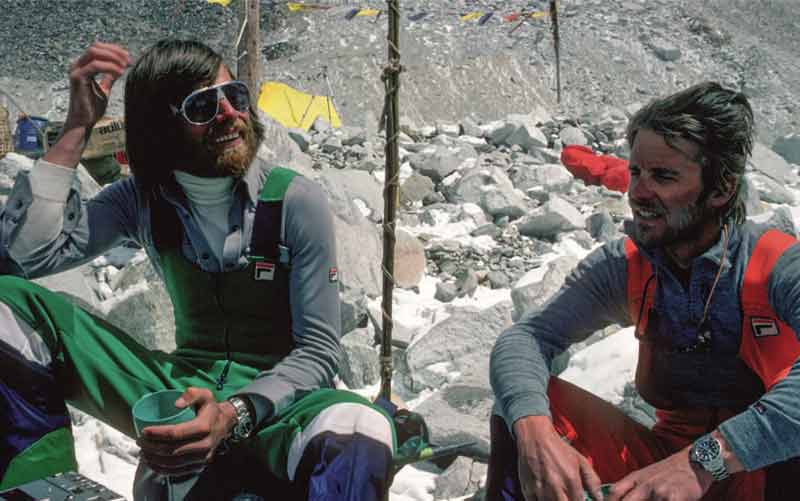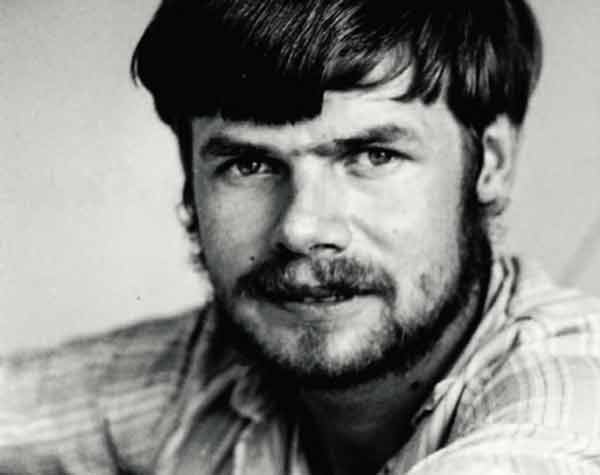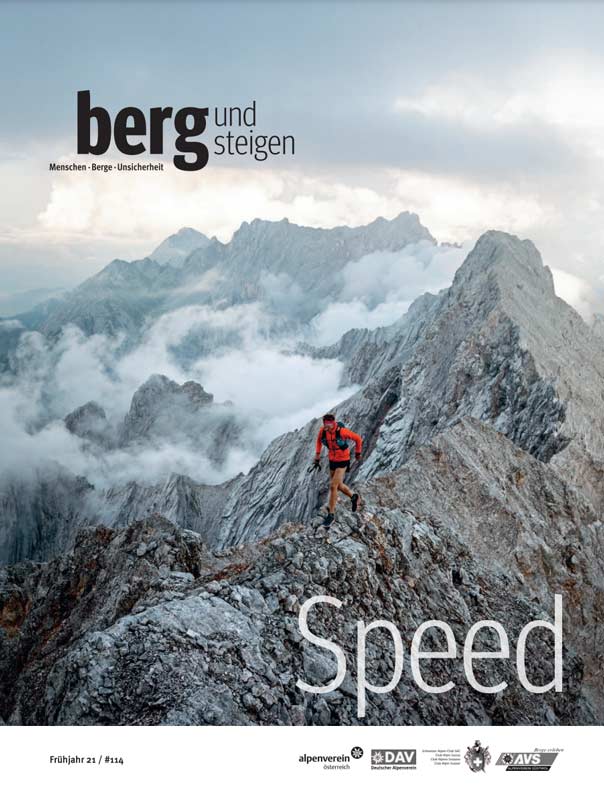The book author, museum curator and retired alpinist Reinhold Messner on wives, fathers and friends as mountain partners, the abuse of the word camaraderie - and envy as a companion.
Interview by Gebi Bendler and Dominik Prantl - first published in the trade journal bergundstieg
Reinhold Messner receives an interview in his Juval Castle in South Tyrol;
it will be waiting at the entrance at the agreed time and lead into a high, wood-paneled room with a large flat-screen TV and floor lamp. There, Messner takes three hours to talk, occasionally scolding journalists, mocking many mountaineers and, despite his 76 years, by no means leaves an old-weary impression. At the end he personally fetches a bottle of red wine - which unfortunately runs out too quickly.
Mr. Messner, who is your favorite rope partner on the mountain right now? My wife.
Can life partners be good rope partners at the same time?
Why not! There are examples of this, especially in early mountaineering. Or later about Rudi and Helga Lindner. By the way, Paul Preuss, to whom I also feel connected, writes in a funny article: "When I was 17 - maybe there were 27 - women - only connected through the rope."
Unfortunately, experience teaches us that it is often difficult to combine a rope team and a love life.
I also never had a life partner with whom I would have gone on difficult tours. That did not happen. What I did back then, no woman in my area could have done either. My wife and I are not a climbing couple either. We climb mountains, like the highest mountain in Ethiopia just before the pandemic - as part of my mountain people studies. We do via ferratas and easy climbing tours. But nothing that could cause stress or tension. I'm beyond the time for extreme tours.
What distinguishes a good partner on the mountain?
He or she must clearly be able to cope with the difficulties that are likely to be faced. If the experience is not big enough, it is manageable as a partner. The main problem is to endure the exposure, so how far are you from the last hedge, the back cover? If the partner breaks down mentally before the task at hand, then it cannot be solved either. So hands off.
Even you started out small. Who took you away?
The partners have grown to me. Even as naive children, we climbed the Geisler peaks in front of our front door, and as boys at 13 or 14 years of age we have already done relatively long tours. Later I was lucky enough to find older partners who were more experienced and who corrected what I couldn't: build clean stands, lay intermediate backups. I put it all together: These naive experiences at a young age, the instinct that was built up with them and the school of Sepp Mayerl, my great teacher. Only later did the problem arise that we - Peter Habeler was also his student - became known far beyond him through the expeditions. It's only interesting from a psychological point of view: that teachers often can't stand to be overtaken.
Who did you get outperformed by?
I didn't have the problem.
Which? To be outflanked or to be jealous?
After 1970 I couldn't climb as extreme as before because of my amputated toes. Because I was forced to renounce my passion for climbing, as a high-altitude mountaineer, I was unable to experience any rivalry with the younger generation of climbers.
You are now in your third marriage. How many people have you had a long-term, marriage-like rope relationship with?
During my alpine tours I had half a dozen rope partners with whom I often went climbing. I made ten first ascents with some of them. With Günther, my brother, dozens. At some point I reduced the expeditions to just a few people on the eight-thousanders, so we were basically always the same. Oswald "Bulle" Oelz, Wolfi Nairz, Friedl Mutschlechner, Hans Kammerlander. And of course Peter Habeler.
Is it deceptive, or is your books - apart from your brother - rather less about your rope partners. So, if climbing partners are extensively acknowledged in mountain books, then in my books! They were not only important to me when I was on the road, but also in what I said about them. I really want to read these chapters. Why are the mountain comrades Kammerlander and Habeler the most successful in the German-speaking area today?
"But nothing is as easy to sell as the 'bad comrade' Messner."
Reinhold Messner
Because they are good?
Because they were great and I made them great! With my books and in my lectures. But nothing is as easy to sell as the “bad comrade” Messner. And when people hire managers - like Kammerlander - or ghostwriters - like Habeler - that says a lot. I know the journalists who play the card “the Messner takes everything”, but are not able to read it up for themselves.
Okay, then let's go over your rope partners. As far as we know, your first was your father. He should have you and your brothers, as you once said, raised like cattle. Was your father's climbing partner on the mountain different from his everyday life?
Yes, but that has to do with something completely different. We lived in a very narrow valley. The rules there were made by the pastor and the mayor; that was like a clan. Child labor was also quite normal. My father was very strict, he was also a teacher in the valley. But in summer we were allowed to go to the Gschnagenhardtalm, the most beautiful alpine pasture in the Dolomites, from the age of five. From there we went mountaineering, and up there the world was as if there was no pastor, no mayor and no teacher. There the cliché “freedom is on the mountain” was also true. Extreme mountaineering means being responsible for yourself; So all freedom, but also all responsibility for each and everyone.
How do you remember the tours with your father?
Good. Very well. He promoted me for a while. At the age of ten or twelve he took me with him, for example to the Big Fermeda. Today you would say three or four tours. But without the right technique, only with a hemp rope and hiking boots, as you had back then. A hammer and a couple of hooks were added later. When he was fourteen he let me lead. That made me strong. My climbing instinct only grew with it. He watched my solo ascent when I was thirteen or fourteen - in the Little Fermeda South Face, a foursome after all.
You made peace with your father.
Clearly. I made peace with all people. I just expect the same solidarity from my partners.
You described your brother Günther, who had an accident on Nanga Parbat, as the best rope partner you can imagine. What made him so special compared to others?
Peter Habeler was clearly a better climber, better than the two of us. But Peter was also two years older than me and four years older than Günther, which is a huge head start at a young age. Günther did his studies - completely normal, and thus had less time to climb than I did. That's why I always led when there were two of us. But he was persistent, a one hundred percent partner. Because we were so familiar as brothers. Also because we had learned the mountain adventure together.
What distinguished Peter Habeler, with whom you climbed Gasherbrum and Mount Everst without bottled oxygen, among others?
Peter Habeler has a genius when it comes to climbing and mountaineering; You have to leave that to him. Why? Because he started doing it very early, also on his own and independently, and then grew out into the world. And: He simply has the instinct that only people gain when they have grown up in the mountains. City dwellers will never have that, at least not with us.
Habeler, on the other hand, described you in interviews with the Standard and the Spiegel as "the best rope partner in the world". Do you have any idea how he came up with it?
Peter understood in later years that the story with his first book "The Lonely Victory" was not a good one. Peter didn't write that, he had it written. The clerk knew exactly how to open it up, namely that the Messner forgets Habeler when he is down again. I would hide the fact that Peter was the first to reach the summit of Gasherbrum. That statement remained until today. Means: “The Messner takes everything and there is nothing for his comrades.” In my book about the ascent of Gasherbrum in 1975, as a highlight, I tell you how Peter Habeler climbed over the summit ridge to the summit in front of me - and I'm still filming the whole thing as proof with a simple camera.
"Peter understood in later years that the story with his first book 'The Lonely Victory' was not a good one."
Reinhold Messner
Because of the book, you temporarily fell out with Peter Habeler.
Back then it triggered a huge number of prejudices that still weigh down on me today, but I do not allow myself to be weighed down. His sentences and my story - something has been turned upside down. I took it to Peter. He promised to fix it. The publisher has done a devil to change that. Why give up the key to selling your book? That's why I say yes: the books are sold on my back. The same thing was done with Hans (Kammerlander, editor's note) and Arved Fuchs (Messner crossed Antarctica with him, editor's note) was able to do the same.
Let's talk about the positive: What was so special about Hans Kammerlander as a rope partner?
Like Peter, he developed this instinct at a young age and learned to survive. And he was in a dream condition. Peter had that too.

Would you call a long-time rope partner like Kammerlander a friend?
I don't refer to either of them as friends. We were communities of convenience. At times there were friendly relationships, but that has disappeared over time. After we had climbed a whole series of eight-thousanders and wandered around South Tyrol, I offered Hans to go to Antarctica with me. All he has to do is learn to navigate. He said: “I don't care.” With that, our actions have diverged in respect. Not in a fight.
Hans Kammerlander sees it a little differently. He says that your life can only be entrusted to a friend. Claims. If you want to read something in depth about comradeship and rope team, you have to read my book about Willo Welzenbach (The Ice Pope. The Welzenbach Files, d. Red.). As you can see there is a lot of cliché. The way in which comradeship, friendship and rope team was understood in Germany is a scandal. There is still a lot to be corrected.
"The way in which comradeship, friendship and rope team was understood in Germany is a scandal."
Reinhold Messner
Historically, the term rope team is often associated with camaraderie until death. Apparently that bothers you.
Yeah, that bothers me. Because it's lies and deceit. Welzenbach was the most important mountaineer of the twenties and thirties. Worldwide. There is no doubt about that. Only the Germans tried to break it.
Paul Bauer, who had undertaken major tours with Welzenbach, went to the minister with the message that Welzenbach was "not capable of comradeship". Who can think of that! Or do you know the story of Erwin Schneider and the Nanga Parbat or Heinrich Harrer at the celebrations "50 years of the Eiger North Face" in Grindelwald?
We weren't there.
I was there. Heinrich Harrer must have given ten or fifteen interviews. And always conjured up camaraderie.
The rope team is the most important thing in mountaineering, the rope team is sacred. And: "In Tibet, too, we went through hell as a rope team." And: "Marriage is also a rope team for life." When asked what he had left of the north face of the Eiger, he said: “The rope team for life - with Heckmair.” I answered and said: “I admire you, but that is not true about the rope team. You climbed the north face with Heckmair and never did another big tour together. And you yourself write that you did not get along with Aufschnaiter in Tibet and therefore split up. ”He then did not utter a word for the entire program. About the rope team is just a cliché, it goes down well. But unfortunately the picture is often not correct.
Have rope partners really only been relationships of convenience for you? No, I have remained friends with some mountaineers, such as Oswald "Bulle" Oelz, for fifty years. But that goes beyond mountaineering and isn't carried by a couple of routes. But also from the intellectual debate. Or the literary interest as with the author Christoph Ransmayr.
In the end, isn't the piste mountaineering you criticized simply a large team? Where everyone is somehow connected, sometimes literally on a fixed rope?
The piste mountaineering is particularly evident in the famous mountains, the Seven Summits, the eight-thousanders. Sherpas go there beforehand and prepare the path like a slope - and the tourists are led up there on a fixed rope chain. Most eight-thousand-meter climbs - including famous people - are made in tow of such expeditions. The infrastructure is there, the exposure removed. But that has nothing to do with mountaineering anymore. There is never a rope team, the vast majority of clients only know their own group, nobody from other teams.

The Nepali are now also very successful in rope teams in the mountains. For example, is the first winter ascent of the K2 by Nirmal Purja still Alpinimus in your understanding?
That is alpinism. First of all, he climbed all eight-thousanders in seven months ...
... but with oxygen. And there are voices from mountaineers who do not believe him that he did the K2 in winter without oxygen.
The oxygen aid is a trifle compared to the preparation of the path. The slope makes the ascent easier than the use of oxygen. It is irrelevant. Oxygen has been part of the tradition since 1922. The conquering alpinism on the really big eight-thousanders worked, among other things, because you learned how to use the oxygen devices. If someone does that without - okay. But when someone goes up the slope and says: me, without oxygen! I can only laugh. The slope is the easiest, mentally, physically and because of the single file effect.
Nirmal Purja only started mountaineering four years ago.
He's not a real mountaineer either. But he achieved a goal on the eight-thousanders that no European had attempted. And then he went to K2 in winter, which 20 expeditions tried before him, sometimes with enormous effort, and failed. As a chronicler, it is relatively unimportant to me as a chronicler whether he walked the whole distance with or without oxygen.
K2 without oxygen - how was it possible?
You're not exactly media-shy. Aren't the media a kind of rope partner for you too? Someone who made you famous and ultimately also made you famous for the 14 eight-thousanders?
Very well. In the beginning, media like the Bunte or the Stern paid really very well for our stories - articles plus pictures.
What do you mean: very good?
15.000 to 20.000 marks. For a story. That was also economically interesting, a give and take. If someone says today that they have climbed a seven-thousand-meter peak in the Himalayas, then in Germany they won't get a cent for it, even from the big magazines.
"It's half as scary to climb a mountain as a couple than alone."
Reinhold Messner
Social media is more like going it alone to stay in the picture of alpinism. Is this the new way: going it alone in the media? Where peace, joy, pancakes can also be staged with your partner?
I am not overvaluing the rope team. But: I can only do great alpinism in rope teams - unless I'm Alex Honnold, who climbs through impossible walls on my own. But normally at least two people are necessary for the technical handling of a traditional tour - and as mutual moral, psychological support. It's half as scary to climb a mountain as a couple as it is alone. Preferably with a friend as a partner.
Looking back, would you describe yourself as a good rope partner?
After I learned from Sepp Mayerl how to properly secure and build stands, I think I did well. I've never lost a partner because I wouldn't have secured properly. Even if I was just lucky sometimes.
About the author

Dominik Prantl has his journalistic home at the Süddeutsche Zeitung, where he writes mainly for the travel section and about mountains. As a neo-Innsbrucker, also actively helps in the bergundstieg editorial team. That's why he rarely makes it into the mountains.
About the magazine bergundstieg

Bergundstieg is an international magazine for safety and risk in mountain sports and illuminates the topics of equipment, mountain rescue, rope technology, accident and avalanche knowledge. Bergundstieg is published by the Alpine Associations of Austria (PES), Germany (DAV), South Tyrol (AVS) and Switzerland (Customer Service).

